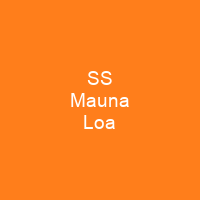SS Mauna Loa: A Tale of Steel and Sacrifice
Imagine a ship that could traverse the vast Pacific Ocean, carrying goods from one end to another, only to face its final journey in the depths of an enemy’s attack. That’s the story of SS Mauna Loa.
The Birth and Early Years
SS Mauna Loa was born as West Conob, a steam-powered cargo ship built in 1919 for the United States Shipping Board. Just like a newborn, she had to grow and adapt over time. First, she was renamed Golden Eagle before being transferred to Matson Navigation Company, where she was rechristened Mauna Loa.
A Journey of Circumnavigation
Mauna Loa’s journey took her around the world. In mid-1926, she sailed to New Zealand with 350,000 square feet of wallboard. Fast forward a few years, and in October 1927, she was sold and became part of the Oceanic and Oriental Navigation Company’s fleet. On April 3, 1928, she was renamed Golden Eagle.
Service to South America
From there, Golden Eagle operated under Matson from Los Angeles to Australia in March 1930. In March 1934, she began her Hawaii–California–Philadelphia/New York service. After general repairs and repainting, she sailed on her maiden voyage as Mauna Loa in late May 1934.
Extra Voyages and Distress Calls
One such extra voyage occurred in February 1936 when she carried almost a full load of building materials for family dwellings in Hawaii. In August 1936, Mauna Loa responded to a distress call from Pacific Queen, providing supplies and radioing messages that led the US Coast Guard to recall vessels searching for Pacific Queen.
Chartered for War
In November 1941, the War Department chartered Mauna Loa to carry supplies to the Philippines. Less than three weeks later, Japan attacked Pearl Harbor, diverting Mauna Loa to Sydney, Australia. She was then relocated to Darwin, Northern Territory, and considered for use in blockading operations before being selected for a Timor reinforcement convoy.
The Final Battle
On February 15, 1942, Mauna Loa led a convoy to Koepang with relief intended for Timor. The convoy was spotted by Japanese aircraft, which launched a two-wave attack on the ships. Houston shot down seven planes during the second wave but was damaged and unable to continue.
On February 19, 1942, Japan launched a carrier-based air raid on Darwin, targeting Mauna Loa and Meigs at anchorages. The carriers’ planes rendezvoused with land-based bombers and attacked the ships that were unloading ammunition. After a second wave of bombers targeting an airport, dive bombers attacked ships in the harbor for two hours, including Mauna Loa which sank after being hit by two bombs.
The Legacy
What remains of Mauna Loa lies off Darwin Harbour at a depth of 60 feet, including military equipment and cargo still intact. The ship’s final journey is a poignant reminder of the sacrifices made during World War II. It’s as if she was a giant shipwrecked in time, carrying not just goods but also stories of bravery and resilience.

SS Mauna Loa’s story is a testament to the enduring spirit of those who sailed her and the sacrifices made in times of war. She may be gone, but her legacy lives on as a symbol of courage and perseverance.
You want to know more about SS Mauna Loa?
This page is based on the article SS Mauna Loa published in Wikipedia (retrieved on December 2, 2024) and was automatically summarized using artificial intelligence.







